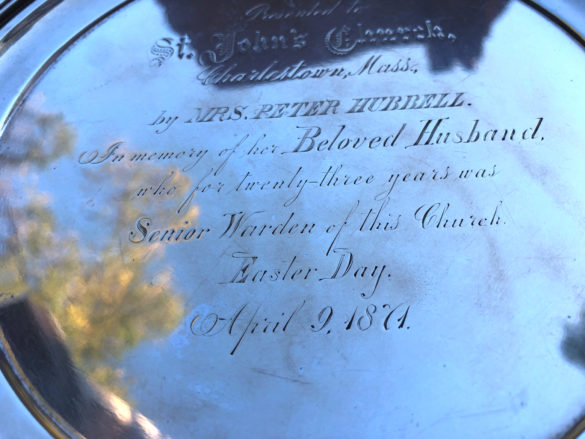Sermon — November 21, 2021
The Rev. Greg Johnston
In a time of national crisis, just a few years before the whole nation would erupt into rebellion and destruction, a man rose from the obscurity of provincial life into sudden prominence. He had a unique combination of strangeness and self-confidence, a charisma that drew many to him even as others turned away, baffled. Viewed as a dangerous upstart by some and an oddball by others, he nevertheless enjoyed some degree of popular support. In time, he was elevated to the company of some of the most powerful political people in the world, declaring himself the sovereign lord and ruler of his people. With no known royal ancestry, no political experience, no military support, nevertheless he stood prepared to take the throne. He was a once-in-a-century figure, a man of such mysterious power that the stories of his life have been told and re-told, disputed and debated, generation after generation and down to the present day.
Of course, there could only be one man I’d be talking about on this last Sunday after Pentecost, on the Feast of Christ the King, and some of you may recognize his name. Yes, that’s right. It’s Norton the First, Emperor of the United States.
If you’ve never heard of Emperor Norton, you’re missing out. He’s one of those figures whose place in the historical record far outstripped his actual significance, because he was simply so strange. Born in England and raised in South Africa, Joshua Abraham Norton immigrated to the United States, arriving in Boston in 1845 and making his way to San Francisco by 1849. America was, at that time, in the final years of our decades-long struggle over the enslavement of human beings, and within ten years of arriving in California, old Joshua Norton had seen enough. In a letter to the editor of the San Francisco Daily Evening Bulletin, Norton declared:
At the peremptory request and desire of a large majority of the citizens of these United States, I, Joshua Norton… for the last 9 years and 10 months past of San Francisco, California, declare and proclaim myself Emperor of these United States; and in virtue of the authority thereby in me vested, do hereby order and direct the representatives of the different States of the Union to assemble in Musical Hall, of this city, on the 1st day of February next, then and there to make such alterations in the existing laws of the Union as may ameliorate the evils under which the country is laboring, and thereby cause confidence to exist, both at home and abroad, in our stability and integrity.
Needless to say, the states did not heed the call to send delegates to a new constitutional convention. As the years went on, Emperor Norton was afforded a certain degree of respect by the citizens of San Francisco, treated with as much dignity and respect as the people of what was then a small town halfway across the world from much of anything could afford.
But nobody took him seriously. Within just two years of his letter, the Civil War would begin; and while certain Americans may argue to this day over whether the Confederacy or the Union was the legitimate continuation of American democracy, there was no Nortonist faction in the Civil War, no third way between North and South, no Californian Empire fighting its way across the continent to “ameliorate the evils under which the country [was] laboring.” You can’t just go around telling people that you’re the king. That’s not how any of this works.
Which leaves us followers of Jesus in a bit of pickle. Because Jesus, in his day, wandering around preaching and teaching about the coming kingdom of God, must have seemed like an ancient Emperor Norton. To be fair, Jesus was a bit slippery on the question of his own kingship. At times, he seems to deny it—“You say that I am a king,” he says to Pilate—but of course his claim that Pilate’s putting words in his mouth is somewhat undermined by the fact that he’d just used the words “my kingdom” three times in the sentence before. (John 18:36-37) It’s clear, in any case, that everyone else thought Jesus was saying he was the king. Not only his enemies, but also his closest friends and disciples, and his followers for a hundred generations have all agreed on one thing: that this man thought he was a king. In fact, even the most skeptical historical scholars of Jesus accept at the very least, as the most basic facts of his life, that Jesus was 1) born, 2) called by some “Christ,” the Messiah, which is to say, the king; and 3) was crucified under an inscription that accused him of being “The King of the Jews.”
It’s important to recognize that this imagery of Christ as King, crowned with many crowns, drowning out all music but his own, can be troubling. “Kingdom” carries the baggage of feudalism and patriarchy, of oppression and violence, of Christian triumphalism and colonial imperialism, of a world in generations of Christians could happily sing “Onward Christian soldiers” as they conquered the world in the name of the cross because, after all, it’s Christ’s kingdom we’re building, not ours.
And it’s a point that’s more than fair. Pick up the Bible, read any book of history and you’ll find that benevolent monarchs are few and far between. Far more common are the grandiose schemers who throw their citizens’ lives away for glory; the malevolent tyrants who crush their subjects like so many ants beneath their feet; the saintly fools who drive their countries into the ground. Our first reading takes up the beautiful last words of David as a prophecy of Christ: “One who rules over people justly…is like the light of morning, like the sun rising on a cloudless day, gleaming from the rain on the grassy land.” (2 Sam. 23:3-4) But David himself wasn’t all blue skies and just rule. In fact, some of you may recall I spent half the summer preaching about what a messed-up guy the great King David really was.
So if this is kingship, who wants Christ the King?
Fair enough. But I want to suggest another way to see things. Perhaps to say that kings are bad, and that Christ is king, doesn’t necessarily mean we should that Christ is bad, or that God’s caught up in some oppressive human scheme. Perhaps it could, instead, transform our idea of what royalty really is. If Christ is King, then true leadership is not to seek one’s own glory, but to serve one’s people humbly. The true king is not the one who spends the lives of those he rules like spare change, but the one who gives his own life to spare them from destruction. True power is not the power over another person that us in all the hierarchy and oppression of earthly kingdoms, but the power of the one who “loves us and frees us by his blood.” (Rev. 1:5)
Jesus “loves us and frees us,” Revelation says. He frees us from sin—from all the destructive and distorting power that the kingdoms of this world hold over us—and “makes us to be a kingdom, priests serving his God and Father.” (Rev. 1:6) Christ frees us from everything that dominates us in this world, from all those who claim that they can judge us or command us or lead us, and Christ frees us for royal priesthood.
What makes Emperor Norton ridiculous is not that he called himself an emperor; many men have done that in history, before him and since. What made him ridiculous was that he tried simply to declare himself emperor, to acquire the trappings of ultimate power and authority over us without holding any actual power to back it up. With Jesus, it was just the opposite. He in fact held all the power in the world, all the power, you might say, in the universe; and yet he gave it all up to set us free from every other power that there was. He doesn’t make himself the Emperor of a one-man empire; he makes us a kingdom several billion strong, royal priests serving our God.
That’s exactly why the title “Christ the King” doesn’t bother me; why, for all my egalitarian politics, I love it. Because if Christ is King—if Jesus is, as Revelation says, “the ruler of the kings of the earth” (Rev. 1:5)—then no one else is. If Christ is King, then anyone and anything that claims your ultimate allegiance or concern is a sham. If Christ is King, then anyone who claims they can condemn or judge you is a liar. If Christ is King, then anyone or anything that tells you you’re not good enough is a fraud, because you are “a kingdom, priests serving his God and Father.”
If Christ is King, and if Christ has made us royal priests, then we are left only to play our part, to love one another and free one another as Christ loves us and frees us, to care for one another and forgive one another as Christ loves and forgives us. Needless to say, none of us is Jesus. Sometimes we’re like David, well-intentioned and good overall but deeply flawed. Sometimes we’re like Norton, ridiculous in our own self-importance. Sometimes we’re just like the countless billions of faithful people who have lived the Gospel, died, and been forgotten. But all of us have been loved and set free by “Jesus Christ, the faithful witness, the firstborn of the dead, and the ruler of the kings of the earth… to him be glory and dominion forever and ever. Amen.” (Revelation 1:5–6)


